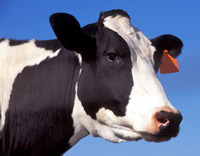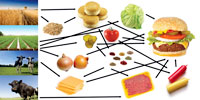
| Home | Information Sharing & Analysis | Prevention & Protection | Preparedness & Response | Research | Commerce & Trade | Travel Security & Procedures | Immigration |

The threat level in the airline sector is High or Orange. Read more.

 Get e-mail updates when this information changes
Get e-mail updates when this information changes
The U.S. Department of Homeland Security’s Science & Technology (S&T) Directorate newsletter: S&T Snapshots, features stories about current research projects and opportunities with laboratories, universities, government agencies, and the private sector. Visit S&T Snapshots Archives for more stories about DHS science and techology efforts.

For more than 50 years, scientists at the Plum Island lab have kept an eye on foot-and-mouth disease, which can devastate livestock and markets for animal products.
Plum Island has given rise to some interesting lore. Perhaps it’s the laboratory’s long history or its secluded location. Whatever the reason, conspiracy theorists and fiction writers alike have tried to link the site to germ warfare, anthrax, and even a purported “monster” found earlier this summer on a beach in nearby Montauk, NY.
But reality offers a completely different story. It’s a tale of how the Plum Island Animal Disease Center (PIADC) has protected America’s livestock and agriculture from the threat of foreign animal diseases for more than half a century. The lab—located off the tip of Long Island—serves as the front line of the nation’s defense against diseases that could devastate markets for livestock, meat, and other animal products. At PIADC, the DHS Science and Technology (S&T) Directorate and the
The center’s primary focus has been helping to prevent foot-and-mouth disease (FMD), which last occurred in the United States in the late 1920s. Research and diagnostic efforts conducted at Plum Island are focused on keeping that disease, and other foreign animal diseases like it, from threatening the multibillion-dollar
“Though the center’s mission may not be as colorful as the fictional pursuits we hear about, its real work is critical to the security of the nation’s agriculture, food supply, and economy,” said PIADC Director
FMD is a livestock disease that afflicts cloven-hoofed animals such as cows, sheep, pigs, deer, and goats. Though it is not infectious to humans, it is the most contagious disease known. FMD is also endemic to many parts of the world. In 2001, the United Kingdom had an outbreak of the disease that resulted in an economic loss of approximately
FMD is a disease of economic importance because to freely export agricultural products and conduct foreign trade, countries must be considered free of FMD. An FMD outbreak in the United States could have devastating consequences, with a cost estimated at
FMD is caused by a virus, of which there are seven types. Among those seven, there are even more variations, resulting in more than
Because current vaccines use live virus, they cannot be manufactured in the United States. Another issue with current vaccines is that their potential use is limited because there is no way to differentiate between a vaccinated animal and an infected animal; both animals test positive for the disease, which affects a country’s ability to become FMD-free after an outbreak. (In 2001, the United Kingdom did not vaccinate animals after the outbreak and instead relied on culling infected and potentially exposed animals. Vaccination typically extends the wait period for being able to export agricultural products by several more months.)
PIADC is developing a new vaccine for FMD that is making strides in technology and options for potential use. The new vaccine uses a small number of genes from the virus—not the whole, live virus—so it can be manufactured in the United States. The new vaccine also allows the possibility to differentiate infected from vaccinated animals.
The vaccine opens up opportunities for countermeasure control in the event of an outbreak and, when finalized, would be the first to be licensed for manufacture in the United States. “This new FMD vaccine shows just how important Plum Island is to staying prepared and protecting the nation’s agriculture,” said Barrett.

Numerous ingredients, from across the country or around the world, go into the making of a cheeseburger. NCFPD is helping agencies and companies with how to keep track of it all.
That cheeseburger you just ordered: where did it come from? Where was it made? Are you sure it’s safe to eat?
How about that pickle on top? And the lettuce, the tomato, and the onion?
We usually don’t think about food safety until we’re asked to, or forced to. Maybe a health warning comes in from the CDC, or news hits about an outbreak of
Bacterial and other kinds of food-borne illness outbreaks often happen by accident, with slipups in food safety and preparation. But researchers at the National Center for Food Protection and Defense (NCFPD) are also thinking about the possibility that the food supply could be sabotaged—contaminated on purpose with biological, chemical, or even radiological agents.
It’s happened before. In 1984, for instance, a cult contaminated a restaurant salad bar, causing more than
As a DHS Center of Excellence based at the University of Minnesota, NCFPD helps governments and companies guard against food contamination, both accidental and intentional. The center’s slate of scientists and experts has developed innovative modeling technologies that simulate where and when food is produced and distributed, from the farm to the dinner table. These technologies also assess the interstate transportation of food, as well as the many imports from around the globe.
This is no small task. According to NCFPD, there are an estimated
However, NCFPD has a valuable ingredient to success: breaking through fears about giving away trade secrets, the center has convinced large food manufacturers and suppliers to share their proprietary data about how much food is made and where it is sent. NCFPD keeps a close hold on this information, applying it to build true-to-life scenarios that show, for example, how
“We have a lot of close collaboration with industry,” said
A major NCFPD project is the Consequence Management System, which uses advanced computer models to predict, track, and then react to contamination incidents (see the screenshots). Developed by
Another major NCFPD project is the Food and Agriculture Sector Criticality Assessment Tool. While still in the design and testing phase, the tool “provides a means of capturing what is truly critical in the food and agriculture sector,” said Shaun Kennedy, the Director of NCFPD. “Knowing what is critical is a prerequisite for effectively identifying those things that need further protection.” Developed in partnership with the National Center for Foreign Animal and Zoonotic Disease Defense, based at Texas A&M University, the tool is now in the hands of a growing number of state agencies that would be affected by an intentional attack.
“A lot of states go by different rules, so this is a common way to determine vulnerabilities and make priorities,” said John Hoffman, a senior research fellow at NCFPD who works with both DHS’s S&T Directorate and its Office of Health Affairs.
More than 30 states are field-testing the assessment tool and working with companies to encourage their participation, and many of those states are even looking to consider the tool as a formal part of their homeland security strategy, Hoffman said. Some insurance companies are also starting to take notice, recognizing the tool’s potential for limiting corporate liabilities. “This is turning into a huge success story,” he said.
To request more information about any of these stories, please e-mail st.snapshots@hq.dhs.gov
This page was last reviewed/modified on September 12, 2008.